
About UsThe Numismatic Bibliomania Society is a non-profit organization promoting numismatic literature. For more information please see our web site at coinbooks.org SubscriptionsThose wishing to become new E-Sylum subscribers (or wishing to Unsubscribe) can go to the following web page link MembershipThere is a membership application available on the web site Membership Application To join, print the application and return it with your check to the address printed on the application. Membership is only $15 to addresses in the U.S., $20 for First Class mail, and $25 elsewhere. For those without web access, write to: David M. Sundman, Secretary/TreasurerNumismatic Bibliomania
Society AsylumFor Asylum mailing address changes and other membership questions, contact David at this email address: dsundman@LittletonCoin.com SubmissionsTo submit items for publication in The E-Sylum, just Reply to this message, or write to the Editor at this address: whomren@coinlibrary.com
BUY THE BOOK BEFORE THE COINYou won't regret it! |
- WAYNE'S WORDS: THE E-SYLUM NOVEMBER 29, 2009
- FANNING NUMISMATIC LITERATURE AUCTION III CLOSES DECEMBER 3, 2009
- BOOK REVIEW: GOBRECHT DOLLARS ILLUSTRATED BY THE COLLECTION OF JULIUS KOREIN
- NEW BOOK: CARSON CITY MORGANS: SILVER DOLLARS BORN OF GOLD
- NEW BOOK: THE COINS FROM MARONEIA AND THE CLASSICAL CITY AT MOLYVOTI
- MORE ON WALTER BREEN AT JOHNS HOPKINS
- MORE ON JAMES J. CURTO
- MORE ON LIFE SAVING MEDALS
- QUERY: BALDWIN'S AUCTION 62 CEYLON PLANTATION TOKEN IMAGES SOUGHT
- QUERY: INFORMATION ON SOURABAYA MINTMASTER JOHANN ANTHONIE ZWEKKERT SOUGHT
- LEIDMAN ENGRAVED 1921 DOLLAR RECOVERED
- NUMISMATIC ITEMS THAT MIGHT BE CONFUSED WITH CHICHÉS
- THE RUSSIAN ORDER OF GLORY MEDAL
- IRAN CONFISCATES NOBEL PEACE PRIZE MEDAL
- RARE BOOK SCHOOL
- ARTICLE DETAILS BRITAIN'S MUSHROOM FARM COUNTERFEITING OPERATION
- ARTICLE TRACES HISTORY OF LAS VEGAS' MILLION-DOLLAR MONEY DISPLAY
- AUGUSTA NATIONAL GOLF CLUB MASTERS TOURNAMENT MEDALS
- FIRST EDITION OF DARWIN'S ORIGIN OF SPECIES SOLD
- HAND MADE KINDLE CASE LOOKS LIKE A BOOK
- FEATURED WEB SITE: WILDWINDS.COM
WAYNE'S WORDS: THE E-SYLUM NOVEMBER 29, 2009

Among our new subscribers this week are Susan Joy, courtesy of Ron Abler, and Mike Ivester. Welcome aboard! We now have 1,272 subscribers.
This week we open with a reminder about David Fanning's upcoming numismatic literature auction, my review of the new book on Gobrecht dollars, and announcements of two other new numismatic books.
Other topics this week include Ceylon coffee tokens, Mintmaster Johann Anthonie Zwekkert, the Russian Order of Glory, golf medals, and a confiscated Nobel Peace prize medal. To learn about two bibliophiles and the white leather skirt, read on.
Wayne Homren
Numismatic Bibliomania Society
FANNING NUMISMATIC LITERATURE AUCTION III CLOSES DECEMBER 3, 2009
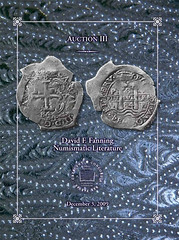 David F. Fanning Numismatic Literature's third mail-bid auction closes on Thursday, December 3. Telephone bids will be accepted through 8:00 p.m. Eastern Time, with e-mail bids accepted through midnight.
David F. Fanning Numismatic Literature's third mail-bid auction closes on Thursday, December 3. Telephone bids will be accepted through 8:00 p.m. Eastern Time, with e-mail bids accepted through midnight.
The sale features many important works of numismatic literature, including many from the Douglas Ball and John J. Ford, Jr. libraries. The catalogue is available in PDF form on the firm's Web site at www.fanningbooks.com. A few hard-copy catalogues remain available. David Fanning can be contacted at (614) 256-8915 or at dfanning@columbus.rr.com .
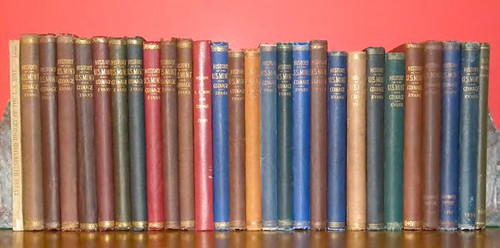
David did a great job of cataloging my collection of Evans' History of the United States Mint (lots 222-248), and I wouldn't be surprised if other catalogers adopt David's classification format, which focuses on the varying CONTENT of the editions, rather than the BINDING variations that attracted me and other bibliophiles. I collected these for years, constantly upgrading or adding new editions and varieties. I still have a few nice ones in my library (a leatherbound copy, and a few of the rare softbounds).
I'm also parting with some nice early Redbooks (lots 406-408). I bought the 3rd and 5th editions in a Kurt Kreuger sale many years ago. They were inscribed by author Richard Yeoman to Hubert Polzer, an early contributor to the book. I must admit though, that I don't know anything about Polzer - did any of our readers know him? Can you tell us anything about him? -Editor
BOOK REVIEW: GOBRECHT DOLLARS ILLUSTRATED BY THE COLLECTION OF JULIUS KOREIN
 Heritage Auctions releases the most complete survey of Gobrecht Dollars to date, illustrated by the collection of Julius Korein, M.D.
Heritage Auctions releases the most complete survey of Gobrecht Dollars to date, illustrated by the collection of Julius Korein, M.D.
Edited by Heritage Chief Cataloger Mark VanWinkle, with essays by Michael L. Carboneau, James C. Gray, John Dannreuther and Saul Teichman
Few varieties of U.S. coinage have been the subject of as much speculation, controversy and admiration as Gobrecht dollars.
Now Heritage Auction Galleries and Ivy Press have released the 136-page book Gobrecht Dollars, the most thorough review to date of the existing scholarship on these much sought-after U.S. coins.
"This reference book, the result of five-and-a-half-years of work, is intended for the general numismatist that is looking for a deeper understanding of these fascinating coins," said Mark Van Winkle, editor of the tome and Chief Cataloger at Heritage Auctions. "It gathers together the diverse threads of the Gobrecht story without delving into the more speculative areas of die markers and their possible consequence for establishing emission sequences."
The overriding question of emission sequences is an area that is, and has been, under investigation for some time and, it is reasoned, will eventually lead to a generally accepted striking order.
"Without a doubt this book is important to a wide range of numismatists, as this information has never been presented together so thoroughly," said Van Winkle. "It is not, however, the last word on this fascinating series."
The book brings together all the best known writings on Gobrecht dollars from the past 20 years and is based upon a series of three articles written by Jim Gray and Mike Carboneau in 1991, 2000, and 2001 and expounded upon by those two writers, along with scholarship by Van Winkle, John Dannreuther and Saul Teichman. The book brings together the most up-to-date findings about Gobrecht dollars based on the coins themselves as primary sources, rather than secondary sources (some of which date to 1860).
"Dannreuther makes a special contribution," said Van Winkle, "with his articles dealing with the die clash line on the reverse of some 1836 dollars, previously thought to be a die scratch, as well as his discovery of the effacement of Gobrecht's name from the post-1836 dies."
What many numismatists will find particularly spectacular about Gobrecht Dollars are the numerous illustrations, more than 100 in all, ranging from glorious full color to detailed black and white images. The spectacular collection of the late Dr. Julius Korein, now permanently impounded in the ANS, has detailed, up-to-date information on each design variant, including alignment, mintage, rarity, weight, pedigree and description.
Each of the 25 Gobrecht issues (including splashers) have been expertly photographed in detail, providing collectors with their best look yet at most every variant, except one: the Judd-109, which, for the purposes of this book, was compiled as a composite photo. More than likely the Judd-109 is unique and hasn't been seen since the late 1960s.
"We're very excited to get this book into the hands of numismatists at all levels of the hobby," said Van Winkle," and we look forward to new findings as research continues on these fascinating coins."
Although the book's subject is a single coin series, its coverage is far from narrow. In fact, its range is broad enough that it reminds me of what I like most about The E-Sylum. It covers its subject from a broad range of perspectives, taking a holistic soup-to-nuts view of its numismatic topic, encompassing not only the coins themselves, but coinage technology, the artists, art and art history, patterns, medals, collectors and collecting, and yes, even numismatic literature - see Jim Gray's Review of Books, Articles, and Other Sources Regarding Gobrecht Dollars.
If you've read my book reviews before, you'll know I have a predilection for taking in books back to front. I guess for me, it's important that a book not peter out, but end with a bang. Attention even to the back of the book indicates attention to detail throughout, and Van Winkle's book didn't disappoint.
The final section is a coin-by-coin inventory of the Korein collection, exactly what I would expect to see in such a book. The penultimate section is the aforementioned Jim Gray essay on the literature of Gobrecht Dollars. The twenty-five entries spanning 1860 to date are not only a bibliophiles delight, but a solid indication that the authors have done their homework on the subject.
I was also delighted to see Mark's brief section From the Logbook of George J. Eckfeldt, a tantalizing view into a journal now owned by Alan Meghrig. Forman of the coining room at the Philadelphia Mint from 1830 to 1860, Eckfeldt kept a log recording which coins and medals were struck on which days.
The book opens with a very accessible explanation of the four different die alignments found on the Gobrecht dollars - the four possible combinations of coin and medal turn with the reverse eagle flying level or upward. See the great illustration (below) of alignments I, II, and III.
Next up is a welcome reprint of a classic article by the late Elvira Clain-Stefanelli, first published in the American Numismatic Association Centennial Anthology in 1991. From the Drawingboard of a Coin-Engraver: Sketches by Christian Gobrecht for the Coinage of 1826-1839 illustrates some fifty sketches and other artworks related to the coins.

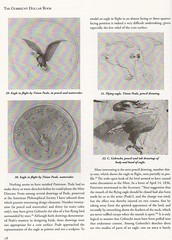
I couldn't locate a listing for the book on the Heritage web site, but it may not have been posted yet. Keep an eye out for the book - it's one I recommend for all numismatists regardless of their specific collecting interests. -Editor
To visit the Heritage Auctions web site, see: www.ha.com
NEW BOOK: CARSON CITY MORGANS: SILVER DOLLARS BORN OF GOLD
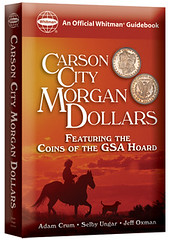 "A Mexican named Francisco Lopez was the first to discover gold in California, in the San Francisquito Canyon near the pueblo of Los Angeles."
"A Mexican named Francisco Lopez was the first to discover gold in California, in the San Francisquito Canyon near the pueblo of Los Angeles."
Thus begins the tale of the California Gold Rush, recounted by Adam Crum, Selby Ungar, and Jeff Oxman in Carson City Morgan Dollars, a new Whitman Publishing book that goes on sale this month (December 2009).
The authors continue: "Yet it was another man's accidental discovery of gold, on January 24, 1848, northeast of Sacramento along the American River, that brought monumental change to what was then one of the farthest outposts of a young United States of America. Ironically, neither the discoverer, James Marshall, nor his employer, Captain John Sutter, were particularly enthusiastic about the find, since Sutter was at work establishing an agricultural empire and Marshall had a sawmill to build. As incredible as it may seem, the two men agreed to keep the gold a secret."
"Predictably, however, word of the discovery eventually got out. The news was met with general disbelief at first, until one Sam Brannan, a storekeeper in Sutter's Creek, paraded a bottle filled with gold dust around San Francisco, shouting ‘Gold! Gold! Gold from the American River!' His stunt ignited the gold rush, and in just nine weeks, Brannan's stroke of genius had rewarded him with a profit of $36,000. His fortune wasn't made in gold, however; Brannan had cleverly reasoned that the first person to sell picks, pans, and shovels would get a lot more gold than the average person who had to dig for it."
The struggles of adventurers in the California Gold Rush . . . the Nevada silver boom of the late 1800s . . . the creation of the Carson City Mint. These are some of the rich historical veins that Crum, Oxman, and Ungar mine in Carson City Morgan Dollars. However, it's not only the Old West history buff who will strike it rich in this book. Collectors and investors will benefit from a detailed coin-by-coin study of every Morgan dollar ever struck at the famous CC Mint, including selected VAM (Van Allen – Mallis) varieties. The General Services Administration hoard—millions of Treasury-bagged silver dollars brought out of storage in the 1970s and sold to collectors—is a fascinating "main character" in this story. The authors describe the government's sales of these coins, and their effect on the hobby. Then they share detailed advice on ways to collect Carson City Morgan dollars.
Each entry has a chart of estimated values in Mint State grades, listing prooflike (PL) and deep-mirror prooflike (DMPL) values separately.
Each "generic" (non-VAM variety) coin has a "By the Numbers" chart, which gives its original mintage, Leroy Van Allen's published estimate of the quantity in the GSA hoard, rarity rankings for GSA and non-GSA examples, and other useful facts. "Overall Rarity" is the total number of coins estimated to exist for the issue, based on the number found in the GSA hoard, the number graded by PCGS and NGC, the authors' personal observations, insider information, auction records, and what the authors call "gut instinct."
James Marshall in front of Sutter's sawmill in Coloma, California. A "Condition Census" provides the most reasonable acquisition grade for most collectors. The highest-known grade fro a given date might include 10 or more coins—then again, it might include only one or two, with perhaps dozens of examples in the next lower grade. To give the huge number of collectors of this popular series a reasonable goal, the authors used as their target grade the top 50 or so coins and called this the Condition Census. ("Though it isn't always possible to acquire the highest-graded coins in GSA holders," they note, "it's still desirable, and fun, to attempt to do so.")
"Collector Insights" give summaries of useful background information on each coin, while "Variety Notes" supply valuable information on the many die varieties known to exist for Carson City Morgan dollars in GSA holders.
With its wealth of data and expert insight, Carson City Morgan Dollars is an important new book for every Morgan dollar collector.
To read the complete article, see: The Whitman Review, December 2009 (www.whitmanbooks.com/Default.aspx?Page=55&HTMLName=ReviewFBook1_1209)
NEW BOOK: THE COINS FROM MARONEIA AND THE CLASSICAL CITY AT MOLYVOTI
 S. Psoma, Ch. Karadima, D. Terzopoulou
The Coins from Maroneia and the Classical City at Molyvoti
S. Psoma, Ch. Karadima, D. Terzopoulou
The Coins from Maroneia and the Classical City at Molyvoti
Athens: Institute of Greek and Roman Antiquity 2008, softcover, 21X28 cm, 437 pp., ill., 132 Euros
Zone, a little known urban site on the Aegean coast of Thrace, was excavated under the auspices of the Greek Archaeological Society; the found coins were summarily listed and reviewed in a 1996 article by Mina Galani-Krikou. A third of these 2229 coins are the critically important coins of Zone that made possible the site's very identification.
In the present volume Selene Psoma of the Research Centre for Greek and Roman Antiquity (National Hellenic Research Foundation), Chryssa Karadima and Domna Terzopoulou of the XIX Ephorate of Prehistoric and Classical Antiquities (Ministry of Culture of Greece) now give us not only a welcome second publication of site coins excavated in Aegean Thrace but one in extended monograph form with commentaries and full attention to numismatic detail. Notably, the study treats the coins from two sites, one that has long been recognized as Maroneia, the other a previously unidentified city site on Cape Molyvoti.
To order a copy of the book, see: The Coins from Maroneia and the Classical City at Molyvoti - A Contribution to the History of Aegean Thrace (www.choosebooks.com/displayBookDetails.do?itemId=99799440&b=1)
THE BOOK BAZARRE
MORE ON WALTER BREEN AT JOHNS HOPKINS
Regarding Walter's Breen's academic achievement at Johns Hopkins University, Pete Smith writes:
 Walter Breen was apparently not involved with extra-curricular activity at Johns Hopkins. Duh! Maybe he was too busy studying.
Walter Breen was apparently not involved with extra-curricular activity at Johns Hopkins. Duh! Maybe he was too busy studying.
Ken Berger writes:
Let's assume a Bachelor's degree consists of 128 semester credits. Let's further assume that each course consists of 4 credits (although 3 credits is more common). Thus, 128 credits divided by 4 credits per course equals 32 courses, further divided by 2 semesters equals 16 courses per semester. Thus, Breen must have tested out of some courses and achieved part of his credit that way.
To read the earlier E-Sylum article, see: WALTER BREEN AT JOHNS HOPKINS (www.coinbooks.org/esylum_v12n47a13.html)
MORE ON JAMES J. CURTO
John Ferreri writes:
A little more on the late James Curto. I usually do not bother saving old correspondence but after I started collecting U.S. Obsolete Banknotes in 1969 I realized I was about to compile a wealth of information just from these writings so I went out and bought a file cabinet for the anticipated influx.
Now, looking back into that file I have found the original folder I assigned to the Curto correspondence. It all started on 6-28-73 when he contacted me about selling notes from his collection of obsoletes. I was barely a newborn to this collecting life and how he located me, I am still not sure. With his first correspondence he even included two proof notes with an asking price. With that first purchase and for the next year and a half through 30+ mailings I was able to form the beginnings of my collection.
Reading through his correspondence today I am reminded that Jim was nothing but a polite, accommodating, extremely fair and often apologetic gentleman, at least to me. We bargained on many notes the asking price of which today would be a mere fraction of their true value. Reading about him recently in this column brings a warm glow to my face.
To read the earlier E-Sylum article, see: ALAN WEINBERG ON JAMES J. CURTO (www.coinbooks.org/esylum_v12n46a16.html)
MORE ON LIFE SAVING MEDALS
Gar Travis writes:
Though different than the privately commissioned medals of Tiffany for various ocean shipborn heroics, these two medals were officially awarded by our government to members of the United States Lifesaving Service. Having been a member of the Coast Guard such medals are of my personal interest.
Date of Rescue: 29 NOV 1909
Station: Cape Hatteras LSS, NC
Date of Award: 6 December 1911
Awardee(s): B. B. Miller
Date of Rescue: 29 NOV 1909
Station: Creed's Hill LSS, NC
Date of Award: 6 December 1911
Awardee(s): E. H. Peel
To read a complete list of Coast Guard Gold Lifesaving Medal Awardees, see: www.patriotfiles.com/index.php?name=Sections&req=viewarticle&artid=2283&page=1
Regarding the 1911 gold New York Benevolent Lifesaving Society medal being auctioned in England, Alan V. Weinberg writes:
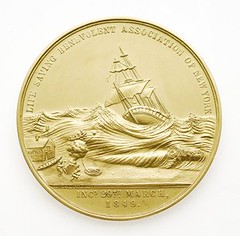 I was offered this very medal via email by P. Edwards, the British jewelery firm owner after e-Sylum member John Sallay heard from him and referred him to me. I offered $2,200 US several months ago when gold was lower.
I was offered this very medal via email by P. Edwards, the British jewelery firm owner after e-Sylum member John Sallay heard from him and referred him to me. I offered $2,200 US several months ago when gold was lower.
The medal was singularly unimpressive as it had an undesirable matte finish and was not at all rare in silver or gold. I've owned five in gold (and seen perhaps 10 in gold) and my 1853 and 1858 gold specimens are pictured, along with a great many other medals, on John Sallay's www.neocollect.com website.
All five that I've owned were pre- 1907 (the medal was first issued in 1849) with the much more desirable prooflike fields. Matte fields - as with this 1911 gold medal - are considered undesirable by many collectors as that is the modern finish seen on so many medals. A matte finish gold 1926 NY Benevolent Lifesaving medal was for sale at the Los Angeles ANA bourse and finally sold for about $3000.
To read the earlier E-Sylum article, see: 1911 GOLD TIFFANY LIFE SAVING MEDAL OFFERED (www.coinbooks.org/esylum_v12n47a17.html)
QUERY: BALDWIN'S AUCTION 62 CEYLON PLANTATION TOKEN IMAGES SOUGHT
Kavan Ratnatunga of Sri Lanka writes:
I understand that the Ceylon Plantation Tokens (Lots 795-803) of the Balwin's Auction 62 held on 2009 Sept 29, was won by a single person. I would very much like to contact that person to try get a few scans of some tokens which sold at that auction, for my website http://coins.lakdiva.org/coffee/.
If the buyer is on this List or if someone knows the buyer, please put me in contact. My E-mail address is kavanr@gmail.com, Skypename kavanrat.
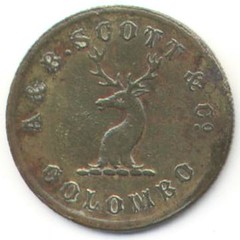

The majority of the copper tokens were issued by Coffee Mills in Ceylon during the years when there was a dearth of small change prior to 1870. A minority were struck later until the early 1880's. When the decimal currency system was introduced in 1869 and coins expressed in cents or divisions came into circulation in 1872, the need for special tokens or tallies decreased and by the year 1890 the majority of the estates and firms were using the legal coin. No copper tokens were ever struck for the Government factories.
Coffee-Planting in Ceylon is described in article published in 1851 June by Harper's Magazine, New York.
In 1889, J. Atkins included 5 specimens in his list. In 1895, Lt. Col. B. Lowsley cataloged 43 in his monograph on the Coins and Tokens of Ceylon which appeared in the Numismatic Chronicle. In 1940 and 1945, Sidney K. Eastwood lists 47 in Numisma which was privately printed in Pittsburgh. In 1953 Scaife of Pittsburgh lists 65 in a series of articles in the ANA Numismatist. In 1961 Pridmore catalogs 120 of which the extra are mostly of local fabrication. Only about a dozen have mint dates. Mitchiner lists a subset of 15 pieces struck in well equipped mints in England or India and are listed below with a few more. The other dates give below are from published records if available.
QUERY: INFORMATION ON SOURABAYA MINTMASTER JOHANN ANTHONIE ZWEKKERT SOUGHT
Jim Duncan writes:
I have Pridmore and Bucknill, both of which are helpful, but I can't determine his date of birth (Jafna in Sri Lanka) or details of where he trained as a Doctor, presumably for the VOC. He served as a master for Batavia, the French, the British, and finally the Dutch, and was highly thought of. He deserves a record. Any help would be gratefully received and appreciated.
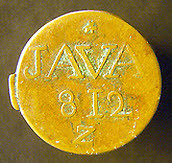
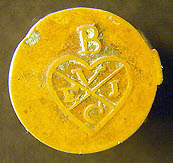
To read the complete article, see: The East India Company outside India (www.mernick.org.uk/lnc/talks/1999sep.htm)
THE BOOK BAZARRE
LEIDMAN ENGRAVED 1921 DOLLAR RECOVERED
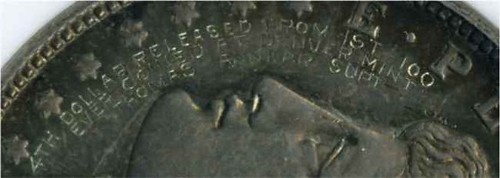
To read the earlier E-Sylum article, see: COIN DEALER JULIAN LEIDMAN VICTIM OF VEHICLE BURGLARY (www.coinbooks.org/esylum_v12n42a11.html)
NUMISMATIC ITEMS THAT MIGHT BE CONFUSED WITH CHICHÉS
- Any cast item with one or two sides -- not a cliché.
- Die-struck uniface medal - may or may not be a cliché.
- Die-struck uniface lead (or other soft metal) proof - is ocalled a cliché.
- A splasher (always one-sided) - is called a cliché.
Die-striking with two thin blanks -- is a TRUE cliché.
To read the earlier E-Sylum article, see: 1772 RESOLUTION AND ADVENTURE MEDAL CLICHÉS (www.coinbooks.org/esylum_v12n47a11.html)
THE RUSSIAN ORDER OF GLORY MEDAL
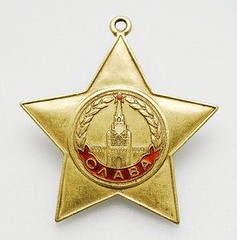 A Russian (Soviet Union) first degree Order of Glory Medals awarded in 1943 will be going under the hammer in November at Birmingham based auctioneers Fellows & Sons.
A Russian (Soviet Union) first degree Order of Glory Medals awarded in 1943 will be going under the hammer in November at Birmingham based auctioneers Fellows & Sons.
The Order of Glory, which was modelled closely upon the Tsarist Cross of St. George, had three degrees. A person initially received the third degree, and would subsequently be promoted to higher degrees for further acts of bravery; one who received all three degrees was called polniy kavaler ordenov slavy (full Cavalier of the Order of Glory). In total only 2620 gold first class orders were awarded and attained this Full Cavalier status.
The Order of Glory became defunct upon the collapse of the Soviet Union. In 2000, the Cross of St. George was revived to serve the same purpose of rewarding bravery in NCO's and enlisted service personnel.
To read the complete article, see: Rare Russian Medals to Go Under the Hammer (www.responsesource.com/releases/rel_display.php?relid=52066)
IRAN CONFISCATES NOBEL PEACE PRIZE MEDAL
Iranian authorities have confiscated Nobel Peace laureate Shirin Ebadi's medal, the human rights lawyer said Thursday, in a sign of the increasingly drastic steps Tehran is taking against any dissent.
In Norway, where the peace prize is awarded, the government said the confiscation of the gold medal was a shocking first in the history of the 108-year-old prize.
Ebadi won the Nobel Peace Prize in 2003 for her efforts in promoting democracy. She has long faced harassment from Iranian authorities for her activities - including threats against her relatives and a raid on her office last year in which files were confiscated.
The seizure of her prize is an expression of the Iranian government's harsh approach to anyone it considers an opponent - particularly since the massive street protests triggered by hard-line President Mahmoud Ahmadinejad's disputed June 12 re-election.
Acting on orders from Tehran's Revolutionary Court, authorities took the peace prize medal about three weeks ago from a safe-deposit box in Iran, Ebadi said in a phone interview from London. They also seized her Legion of Honor and a ring awarded to her by a German association of journalists, she said.
To read the complete article, see: Iran seizes rights lawyer's Nobel Peace medal (apnews.myway.com/article/20091127/D9C7IK9G2.html)
RARE BOOK SCHOOL
"Rare Book School (RBS) is an independent, non-profit and tax-exempt institute supporting the study of the history of books and printing and related subjects," per its leaflet. It is headquartered at the University of Virginia, but classes are held in Charlottesville, Washington, Baltimore, and New York. Each year, RBS offers about 20-30 5-day non-credit courses for adults on topics concerning book history, old and rare books, manuscripts, and special collections.
For 2009, for example, from 5-9 January there was a seminar in the History of Bookbinding (in Baltimore), 8-12 June, Electronic Texts and Images (in Charlottesville), 22-26 June, Rare Book Cataloging (in Charlottesville), and 27-31 July, Book Illustration Processes to 1900 (in Charlottesville).
This really only scratches the surface; they hold a course annually on Publishers' Bookbindings, 1830-1910, for example (no place stated). Plenty of courses are shown as upcoming for 2010, though with no dates or places.
For course descriptions and application forms, see www.rarebookschool.org
How this might fit into people's busy schedules I do not know, but the courses are only a week long, and you would sit in the company of other bibliomaniacs. If it works out, you might even offer to teach a course yourself on Rare Numismatic Books!
THE BOOK BAZARRE
ARTICLE DETAILS BRITAIN'S MUSHROOM FARM COUNTERFEITING OPERATION
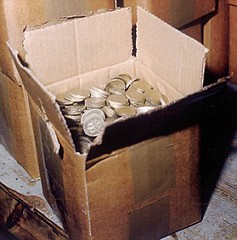 Down a private lane in an Essex backwater, past a breaker's yard, a stable and a fishing pond, the police finally arrived at a small mushroom farm. High hedges and green fencing deterred prying eyes. Behind the foliage were a couple of World War II-style Nissen huts covered in a thick layer of green tarpaulin, insulation for the mushrooms. But when the police forced open the padlocked double doors, instead of fungi they found a sprawl of builder's junk, ancient machinery and old furniture.
Down a private lane in an Essex backwater, past a breaker's yard, a stable and a fishing pond, the police finally arrived at a small mushroom farm. High hedges and green fencing deterred prying eyes. Behind the foliage were a couple of World War II-style Nissen huts covered in a thick layer of green tarpaulin, insulation for the mushrooms. But when the police forced open the padlocked double doors, instead of fungi they found a sprawl of builder's junk, ancient machinery and old furniture.
Cardboard boxes and polythene wrapping were piled up in front of two wardrobes, and sacks of sand and grit were stacked next to a cement mixer. A blue tarpaulin lay in a bundle on the floor and a couple of rubbish bags filled with old UHT milk cartons were lined up by the wall. A Robbie Williams poster hung on the door.
Among this scattering of rubbish, carefully piled on a makeshift bench, were several smaller cardboard boxes, each sealed with gaffer tape. Inside the boxes were thousands of shiny £1 coins. This was what the officers were looking for.
In the next, slightly tidier but equally makeshift hut, there were several more identical boxes. They too were filled with coins. A couple of buckets next to a cement mixer were filled with more. It was a sizeable hoard - more than 70,000 £1 coins.
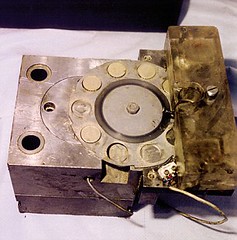 In this improvised workshop was all the equipment needed to turn blank discs into £1 coins: a couple of old-fashioned-looking machines, a digital weighing scale, another cement mixer and a bank of CCTV monitors.
After weeks of investigation I have tracked down one of the main members of the mushroom-farm syndicate, one of Britain's most successful coin-counterfeiting operations. Bill Cook, 62, got four years for his part in the operation, but is now out of jail, living on a barge on the Lee Valley canal.
In this improvised workshop was all the equipment needed to turn blank discs into £1 coins: a couple of old-fashioned-looking machines, a digital weighing scale, another cement mixer and a bank of CCTV monitors.
After weeks of investigation I have tracked down one of the main members of the mushroom-farm syndicate, one of Britain's most successful coin-counterfeiting operations. Bill Cook, 62, got four years for his part in the operation, but is now out of jail, living on a barge on the Lee Valley canal.
'We'd put 5,000 blanks at a time into vibrating machines along with a jewellery-cleaning compound and a drop of water. By the time the machine had finished its cycle, the blanks were nice and clean.'
Cook and another member of the syndicate, Chris Turner, would then transfer these blank coins to another vibrating machine and mix them with a sand-like substance, Maizorb, which dried and polished the pieces of metal.
Next the coins went into a rotating wheel that pressed them against plates that imprinted them with lettering and milled edges.
The third stage saw the coins fed into a hydraulic stamping press that contained Perspex blocks housing the two cast-metal dies used to stamp the blanks. These dies were copies derived from genuine £1 coins. The syndicate was supplied with a variety of different designs.
'The blanks are squeezed at around 40psi, which means the sides are pushed out, and this imprints the lines on the edges,' says Cook. The machine finally throws out newly minted pounds.
Once out of the stamping machine, Cook and Turner would shovel batches of 20,000 coins into a cement mixer, which would churn the freshly polished and golden-hued fakes to the point where they had a suitably 'aged' appearance. On a good day Cook could produce as many as 20,000 coins, though he says it was usually closer to 10,000.
'We'd start the process off on a Monday and make sure that the coins were ready and bagged up by Friday ready for the weekend. We had a weighing machine and the coins would be split up into bags of 1,000. Each batch weighed 21lb.'
To read the complete article, see: Heads or tails? One of these £1 coins is a fake. Today every one in 40 is a counterfeit (www.dailymail.co.uk/home/moslive/article-1230900/Heads-tails-One-1-coins-fake-Today-40-counterfeit.html)
ARTICLE TRACES HISTORY OF LAS VEGAS' MILLION-DOLLAR MONEY DISPLAY
Mr. Sun: My question is about Binion's $1 million display. I have run across conflicting accounts that I'm hoping you can straighten out. Some sources state that the display first appeared at the Horseshoe in downtown Vegas in 1964. Other sources say it first appeared in the 1950s in a different club and moved to the Horseshoe in 1964.
— Len Ratzman
The collection of 100 $10,000 gold certificates, encased in plastic and on public display, was first unveiled Dec. 11, 1954, at the newly remodeled Joe W. Brown Horseshoe Club.
The moment was captured in a photograph that appeared on the front page of the following morning's Review-Journal. The caption noted the display was "another first" for Las Vegas.
With that $1 million display, Brown, a soft-spoken Southerner credited with Fremont Street's transformation into Glitter Gulch, created the Mirage volcano of its era. The display and its successor would for decades be the city's most popular attraction — an estimated 5 million tourists snapped photos in front of the bills.
But inflation, the decline of downtown and the rise of casino-front attractions on the Strip took their toll.
The confusion over the date of the display's unveiling likely arises because Brown, who had purchased the Horseshoe from Benny Binion in 1953, sold his $1 million display in 1959.
In 1964 Benny Binion, who had by then bought back the Horseshoe from Brown, re-created the attraction with another collection of $10,000 bills.
Two unveiling dates. Two owners. Same casino.
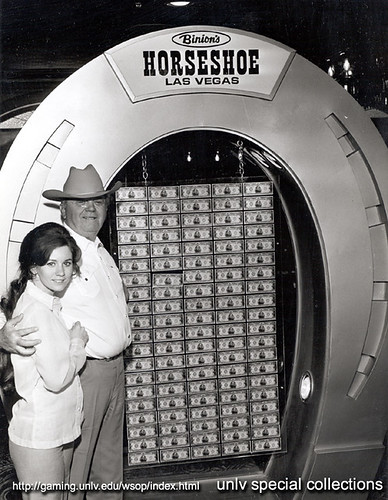
This photo shows Benny Binion in front of the
million dollar display with his daughter Becky.
It was Binion's collection of bills that his daughter Becky Behnen sold in 2000 to Kansas City coin collector Jay Parrino.
The Treasury Department stopped distributing $10,000 bills, which featured former U.S. Supreme Court Justice Salmon Chase, in 1969. By 2000 only 340 remained in circulation, making the display the most valuable currency collection in the world, according to experts.
When the current owners of the casino, now known as Binion's, decided last year to evoke the property's history by creating a new $1 million display, they assembled $270,000 in $100 bills, $688,000 in $20 bills and $42,000 in $1 bills.
The owners estimated replicating the original display by gathering $1 million worth of the $10,000 bills would have cost $16 million.
To read the complete article, see:
When did Binion's $1 million display appear?
(www.lasvegassun.com/news/2009/nov/25/
when-did-binions-1-million-display-appear/)
AUGUSTA NATIONAL GOLF CLUB MASTERS TOURNAMENT MEDALS
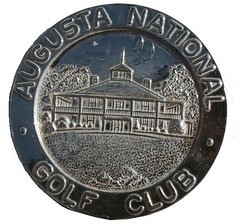
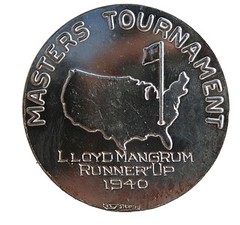
The 1940 Masters Tournament runner-up medal given to Lloyd Mangrum has been sold at auction for $9,775.
Kenley Matheny, president of thegolfauction.com, said that price included a 15 percent buyer's premium.
Only one bid came in for the silver medal, and it matched the reserve price of $8,500. The auction did not end until after midnight Sunday, according to Matheny.
To read the complete article, see: Masters medal sold at auction (chronicle.augusta.com/stories/2009/11/24/gol_556953.shtml)
Gold is out and silver is in, at least for an online auction house that is selling Lloyd Mangrum's 1940 runner-up medal from the Masters Tournament.
Mr. Mangrum's grandson produced the original silver medal after hearing about a gold replica being discovered in October.
Larry Brooks, of McIntosh, N.M., found a gold coin in the bottom of a golf bag he purchased for $5 at a thrift store. The coin was inscribed with Mr. Mangrum's name and featured Augusta National Golf Club's distinctive logo of the outline of the United States with a flagstick marking Augusta.
However, only winners of the Masters receive gold medals, and those who finish second receive silver ones. An online site, thegolfauction.com, put the gold medal up for sale with a reserve of $8,500 while continuing to investigate its origins.
That's when Mr. Mangrum's grandson, who lives in the Albuquerque, N.M., area, stepped forward. He said the coin had been passed on to his mother, who was one of the golfer's three children, and she gave it to her son.
He made two gold replicas, at a total cost of about $400, and used them as markers for his ball when playing golf, he said. He gave one to a friend, but it was lost when his golf bag was stolen from his truck about 12 years ago. It turns out that same bag is the one Mr. Brooks found for sale near his home.
The online auction house verified the story of the grandson, who asked it not to identify him, and replaced Mr. Brooks' gold coin with Mr. Mangrum's silver one.
"I'm just glad we were able to get on this and figure out what the real story of the medal is," said Kip Ingle, the marketing director for the Atlanta-based site.
Masters items of that caliber are rare, Mr. Ingle said. The gold medal given to 1941 Masters winner Craig Wood fetched "well into five figures" when it was auctioned a few years ago, he said.
To read the complete article, see: Masters runner-up medal auction ends tonight (chronicle.augusta.com/stories/2009/11/22/gol_556694.shtml)
FIRST EDITION OF DARWIN'S ORIGIN OF SPECIES SOLD
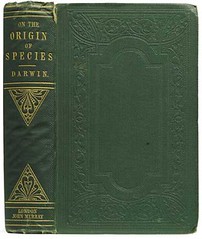 A rediscovered first edition of Charles Darwin's (1809-1882) 'On the Origin of Species by Means of Natural Selection' sold today at Christie's in London for £103,250 / $170,569 / €114,298 (estimate: £40,000 to £60,000). Recently rediscovered sitting on a bookcase in the guest bathroom of the vendor's house, it had been bought for only a few shillings over 50 years ago. The book was sold 150 years to the day after this seminal work of scientific literature was first published (November 24, 1859). It was bought by an anonymous client bidding by telephone.
A rediscovered first edition of Charles Darwin's (1809-1882) 'On the Origin of Species by Means of Natural Selection' sold today at Christie's in London for £103,250 / $170,569 / €114,298 (estimate: £40,000 to £60,000). Recently rediscovered sitting on a bookcase in the guest bathroom of the vendor's house, it had been bought for only a few shillings over 50 years ago. The book was sold 150 years to the day after this seminal work of scientific literature was first published (November 24, 1859). It was bought by an anonymous client bidding by telephone.
Margaret Ford, Director and Head of Books and Manuscripts, Christie's London: "It is a very fitting occasion to have sold this rediscovered copy of Darwin's 'Origin of Species' 150 years to the day after it was first published. One of the most important and influential scientific books ever written, the copy sold today was an unusual rediscovery having been found in the guest bathroom of the vendor's house. We are thrilled to have seen so much interest for the book leading up to the auction where clients competed in the room and by telephone, with an anonymous telephone bidder winning the battle and acquiring it for £103,250."
The vendor's son-in-law was recently visiting an exhibition on Darwin when he noticed a first edition of the book on display. Seeing the distinctive green spine, he recognized it as a book on a bookcase in the guest bathroom of his father-in-law; he found there a fresh copy of a rare first edition of the book. It was this copy that sold today at Christie's for £103,250 / $170,569 / €114,298.
Charles Darwin (1809-1882) is most recognized for his theory of evolution, which states that all species of life have evolved over time from common ancestors. His most notable publication was 'On the Origin of Species by Means of Natural Selection' which was first published on November 24, 1859, and which became one of the most influential scientific books ever written. He was buried in Westminster Cathedral alongside Sir Isaac Newton, and is one of only 5 non-Royal Brits to be honored by a State Funeral, the others being Lord Nelson, The Duke of Wellington and two former Prime Ministers; Lord Palmerston and the Rt. Hon. William Gladstone.
To read the complete article, see: First Edition of Charles Darwin's 'On the Origin of Species' Sells for $170,569 (www.artdaily.org/index.asp?int_sec=2&int_new=34521)
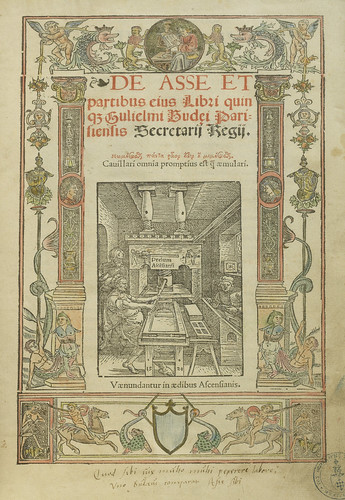
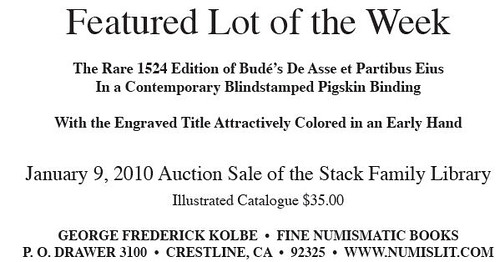
HAND MADE KINDLE CASE LOOKS LIKE A BOOK
Dan Friedus writes:
I'm not sure if E-Sylum readers would laugh or cry but some may be interested to see this cover for a Kindle. I suppose one could have a faux hardbound Chapman catalog version made, given the appropriate leather (skirt).
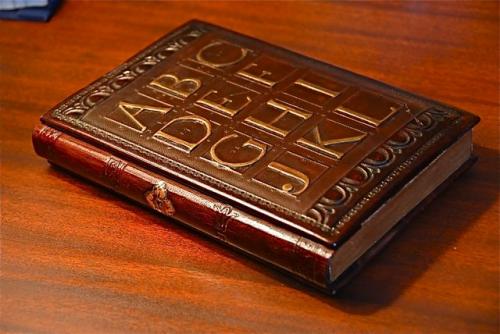
Dan's note alludes to a famous story involving numismatic bibliophile Armand Champa and bookbinder Alan Grace. Alan was visiting Armand, who was asking him to rebind a numismatic auction catalog of the Chapman brothers in white leather, matching the iconic color of the Philadelphia dealers' numismatic literature sale catalogs. Alan had already bound a number of Armand's Champa sales in white leather.
But Alan was having a hard time - his supply of white leather had dried up and at the time it was nearly impossible to find. As the story goes, Armand's wife Kay sashayed across the room wearing an outfit with a white leather skirt. Alan and Armand gave each other the "are you thinking what I'm thinking?" look, and after promising Kay enough money for a few brand new outfits, Armand gave Alan had the supply of material he needed to bind the catalog. -Editor
To read the complete article, see:
Hand Made Kindle Case Mod Made to Look Like a Book
(blogkindle.com/2008/03/hand-made-kindle-case-mod
-made-to-look-like-a-book/)
FEATURED WEB SITE: WILDWINDS.COM
This week's Featured Web site is Wildwinds.com, the online reference, attribution & valuation site for ancient Greek, Roman and Byzantine coins maintained by Dane Kurth.

www.wildwinds.com
